Discover 50 hidden attractions, cool sights, and unusual things to do in Turkey. Don't miss out on these must-see attractions: Hagia Sophia (Istanbul), Topkapı Palace (Istanbul) or Blue Mosque (Istanbul).
Below, you can find the list of the most amazing places you should visit in Turkey.
Table of Contents
Hagia Sophia, Istanbul
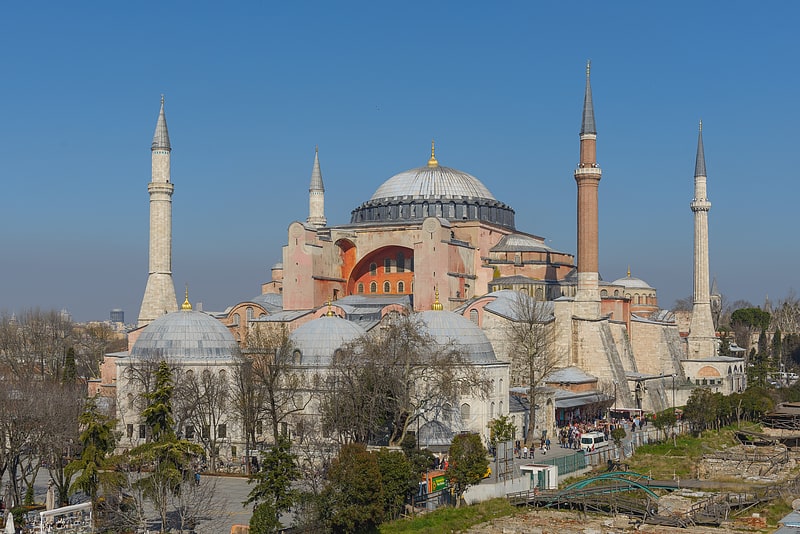
Also known as: Ayasofya
Byzantine basilica museum with mosaics. Hagia Sophia, officially known as the Holy Hagia Sophia Grand Mosque and formerly as the Church of Holy Wisdom, is a Late Antique place of worship in Istanbul, designed by the Greek geometers Isidore of Miletus and Anthemius of Tralles. Built in 537 as the patriarchal cathedral of the imperial capital of Constantinople, it was the largest Christian church of the eastern Roman Empire and the Eastern Orthodox Church, except during the Latin Empire from 1204 to 1261, when it temporarily became a Roman Catholic cathedral. In 1453, after the Fall of Constantinople to the Ottoman Empire, it was converted into a mosque. In 1935, the Republic of Turkey established it as a museum, a role it served for 85 years until it its status was annulled and it was re-converted into a mosque in 2020.
Built by the eastern Roman emperor Justinian I as the Christian cathedral of Constantinople for the state church of the Roman Empire between 532 and 537, the church was then the world's largest interior space and among the first to employ a fully pendentive dome. It is considered the epitome of Byzantine architecture and is said to have "changed the history of architecture". The present Justinianic building was the third church of the same name to occupy the site, as the prior one had been destroyed in the Nika riots. As the episcopal see of the ecumenical patriarch of Constantinople, it remained the world's largest cathedral for nearly a thousand years, until Seville Cathedral was completed in 1520. Beginning with subsequent Byzantine architecture, Hagia Sophia became the paradigmatic Orthodox church form, and its architectural style was emulated by Ottoman mosques a thousand years later. It has been described as "holding a unique position in the Christian world" and as an architectural and cultural icon of Byzantine and Eastern Orthodox civilization.
The religious and spiritual centre of the Eastern Orthodox Church for nearly one thousand years, the church was dedicated to the Holy Wisdom. It was where the excommunication of Patriarch Michael I Cerularius was officially delivered by Humbert of Silva Candida, the envoy of Pope Leo IX in 1054, an act considered the start of the East–West Schism. In 1204, it was converted during the Fourth Crusade into a Catholic cathedral under the Latin Empire, before being resturned to the Eastern Orthodox Church upon the restoration of the Byzantine Empire in 1261. The doge of Venice who led the Fourth Crusade and the 1204 Sack of Constantinople, Enrico Dandolo, was buried in the church.
After the Fall of Constantinople to the Ottoman Empire in 1453, it was converted to a mosque by Mehmed the Conqueror and became the principal mosque of Istanbul until the 1616 construction of the Sultan Ahmed Mosque. Upon its conversion, the bells, altar, iconostasis, ambo, and baptistery were removed, while iconography, such as the mosaic depictions of Jesus, Mary, Christian saints and angels were removed or plastered over. Islamic architectural additions included four minarets, a minbar and a mihrab. The Byzantine architecture of the Hagia Sophia served as inspiration for many other religious buildings including the Hagia Sophia in Thessaloniki, Panagia Ekatontapiliani, the Şehzade Mosque, the Süleymaniye Mosque, the Rüstem Pasha Mosque and the Kılıç Ali Pasha Complex. The patriarchate moved to the Church of the Holy Apostles, which became the city's cathedral.
The complex remained a mosque until 1931, when it was closed to the public for four years. It was re-opened in 1935 as a museum under the secular Republic of Turkey, and the building was Turkey's most visited tourist attraction in 2015 and 2019. In July 2020, the Council of State annulled the 1934 decision to establish the museum, and the Hagia Sophia was reclassified as a mosque. The 1934 decree was ruled to be unlawful under both Ottoman and Turkish law as Hagia Sophia's waqf, endowed by Sultan Mehmed, had designated the site a mosque; proponents of the decision argued the Hagia Sophia was the personal property of the sultan. This redesignation drew condemnation from the Turkish opposition, UNESCO, the World Council of Churches, the International Association of Byzantine Studies, and many international leaders.[1]
Address: Sultan Ahmet Mahallesi, Ayasofya Meydanı, 34122 Fatih (Fatih)
Topkapı Palace, Istanbul

Also known as: Topkapı Sarayı
Historic Ottoman-era palace complex. The Topkapı Palace, or the Seraglio, is a large museum in the east of the Fatih district of Istanbul in Turkey. In the 15th and 16th centuries it served as the main residence and administrative headquarters of the Ottoman sultans.
Construction, ordered by the Sultan Mehmed the Conqueror, began in 1459, six years after the conquest of Constantinople. Topkapı was originally called the "New Palace" (Yeni Saray or Saray-ı Cedîd-i Âmire) to distinguish it from the Old Palace (Eski Saray or Sarây-ı Atîk-i Âmire) in Beyazıt Square. It was given the name Topkapı, meaning Cannon Gate, in the 19th century. The complex expanded over the centuries, with major renovations after the 1509 earthquake and the 1665 fire. The palace complex consists of four main courtyards and many smaller buildings. Female members of the Sultan's family lived in the harem, and leading state officials, including the Grand Vizier, held meetings in the Imperial Council building.
After the 17th century, Topkapı gradually lost its importance. The sultans of that period preferred to spend more time in their new palaces along the Bosphorus. In 1856 Sultan Abdulmejid I decided to move the court to the newly built Dolmabahçe Palace. Topkapı retained some of its functions, including the imperial treasury, library and mint.
After the end of the Ottoman Empire in 1923, a government decree dated April 3, 1924 transformed Topkapı into a museum. Turkey's Ministry of Culture and Tourism now administers the Topkapı Palace Museum. The palace complex has hundreds of rooms and chambers, but only the most important are accessible to the public as of 2020, including the Ottoman Imperial Harem and the treasury, called hazine where the Spoonmaker's Diamond and the Topkapi Dagger are on display. The museum collection also includes Ottoman clothing, weapons, armor, miniatures, religious relics, and illuminated manuscripts such as the Topkapi manuscript. Officials of the ministry as well as armed guards of the Turkish military guard the complex. The Topkapı Palace forms a part the Historic Areas of Istanbul, a group of sites in Istanbul that UNESCO recognised as a World Heritage Site in 1985.[2]
Address: Cankurtaran Mh., 34122 Fatih (Fatih)
Blue Mosque, Istanbul
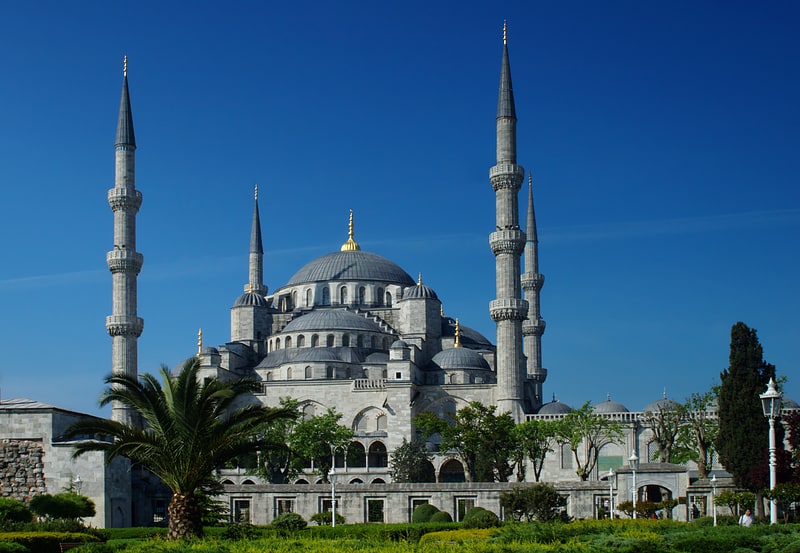
Also known as: Sultan Ahmet Camii
Iconic Blue Mosque with 6 minarets. The Blue Mosque in Istanbul, also known by its official name, the Sultan Ahmed Mosque, is an Ottoman-era historical imperial mosque located in Istanbul, Turkey. A functioning mosque, it also attracts large numbers of tourist visitors. It was constructed between 1609 and 1616 during the rule of Ahmed I. Its Külliye contains Ahmed's tomb, a madrasah and a hospice. Hand-painted blue tiles adorn the mosque’s interior walls, and at night the mosque is bathed in blue as lights frame the mosque’s five main domes, six minarets and eight secondary domes. It sits next to the Hagia Sophia, the principal mosque of Istanbul until the Blue Mosque's construction and another popular tourist site. The Blue Mosque was included in the UNESCO World Heritage Site list in 1985 under the name of "Historic Areas of Istanbul".[3]
Address: Sultan Ahmet Mahallesi, Atmeydanı Cd. No:7, 34122 Fatih (Fatih)
Anıtkabir, Ankara
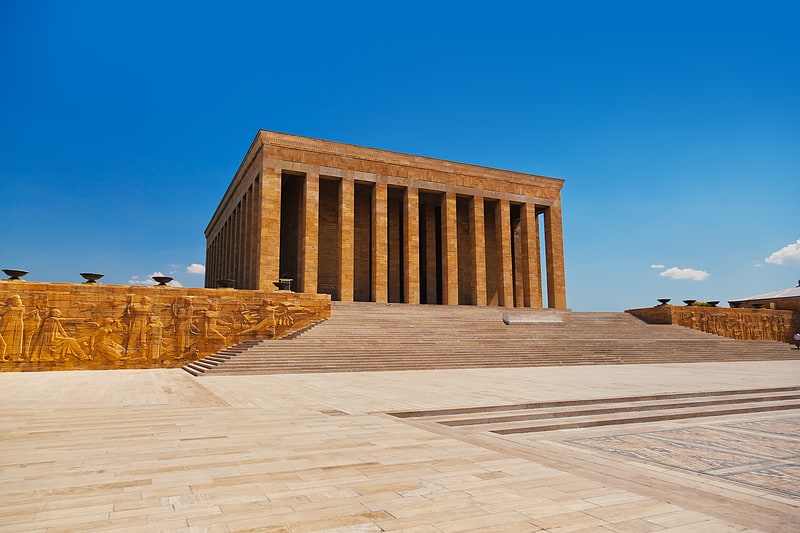
Mausoleum for former Turkish leader. Anıtkabir is the mausoleum of Mustafa Kemal Atatürk, the leader of the Turkish War of Independence and the founder and the first President of Republic of Turkey. It is located in Ankara and was designed by architects Professor Emin Onat and Assistant Professor Ahmet Orhan Arda, whose proposal beat 48 other entries from several countries in a competition held by the Turkish Government in 1941 for a monument for Atatürk.
The site is also the final resting place of İsmet İnönü, the second President of Turkey, who was interred there after he died in 1973. His tomb faces the Atatürk Mausoleum, on the opposite side of the Ceremonial Ground.
The mausoleum was depicted on various Turkish banknotes during 1966–1987 and 1997–2009 and was included in the Turkish Chamber of Civil Engineers list of the fifty civil engineering feats in Turkey, a list of remarkable engineering projects realized in the first 50 years of the chamber.[4]
Address: Mebusevleri Mh., 06570 Çankaya
Museum of Anatolian Civilizations, Ankara
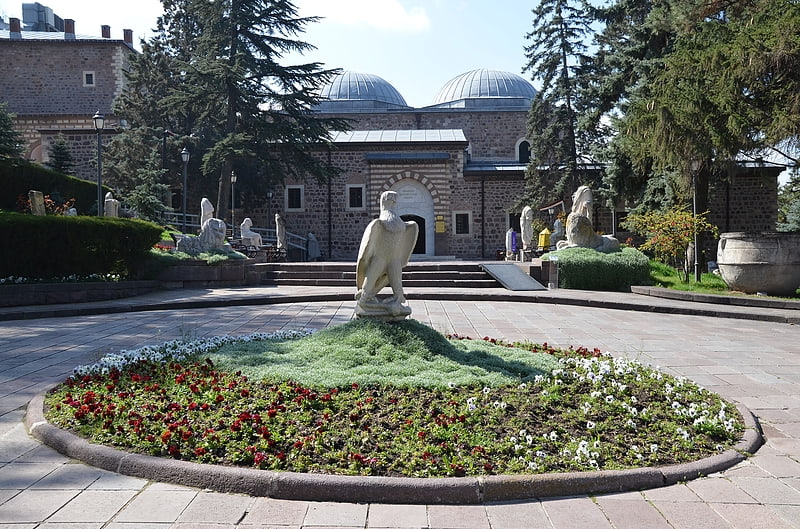
Also known as: Anadolu Medeniyetleri Müzesi
Archaeology displays in Ottoman building. The Museum of Anatolian Civilizations is located on the south side of Ankara Castle in the Atpazarı area in Ankara, Turkey. It consists of the old Ottoman Mahmut Paşa bazaar storage building, and the Kurşunlu Han. Because of Atatürk's desire to establish a Hittite museum, the buildings were bought upon the suggestion of Hamit Zübeyir Koşay, who was then Culture Minister, to the National Education Minister, Saffet Arıkan. After the remodelling and repairs were completed, the building was opened to the public as the Ankara Archaeological Museum.
Today, Kurşunlu Han, used as an administrative building, houses the work rooms, library, conference hall, laboratory and workshop. The old bazaar building houses the exhibits. Within this Ottoman building, the museum has a number of exhibits of Anatolian archeology. They start with the Paleolithic era, and continue chronologically through the Neolithic, Early Bronze, Assyrian trading colonies, Hittite, Phrygian, Urartian, Greek, Hellenistic, Roman, Byzantine, Seljuq and Ottoman periods. There is also an extensive collection of artifacts from the excavations at Karain, Çatalhöyük, Hacılar, Canhasan, Beyce Sultan, Alacahöyük, Kültepe, Acemhöyük, Boğazköy (Gordion), Pazarlı, Altıntepe, Adilcevaz and Patnos as well as examples of several periods.
The exhibits of gold, silver, glass, marble and bronze works date back as far as the second half of the first millennium BC. The coin collections, with examples ranging from the first minted money to modern times, represent the museum's rare cultural treasures.
Museum of Anatolian Civilizations reaching the present time with its historical buildings and its deeply rooted history was elected as the first "European Museum of the Year" in Switzerland on April 19, 1997.[5]
Address: Kale Mh., Gözcü Sk. No:2, 06240 Ulus/Altındağ
Bodrum Castle, Bodrum
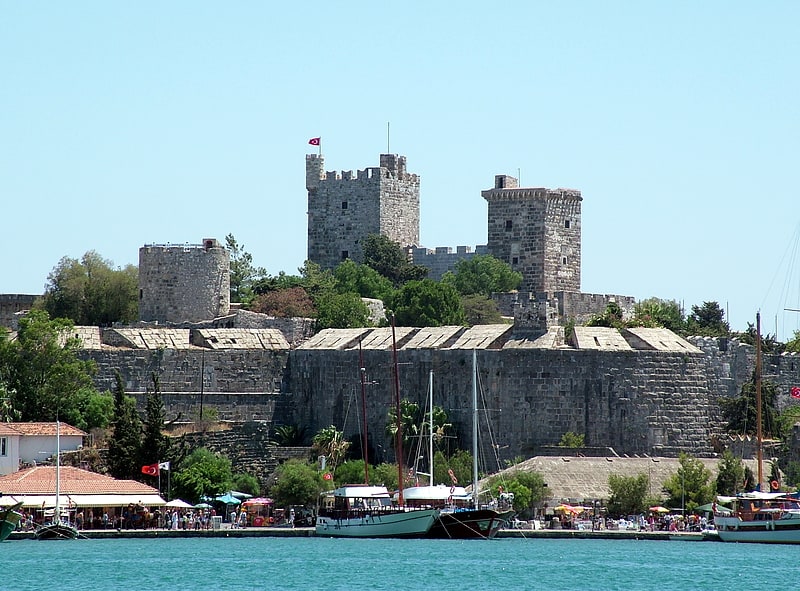
Also known as: Bodrum Kalesi
Fortification in Bodrum, Turkey. Bodrum Castle is a historical fortification located in southwest Turkey in the port city of Bodrum, built from 1402 onwards, by the Knights of St John as the Castle of St. Peter or Petronium. A transnational effort, it has four towers known as the English, French, German, and Italian towers, bearing the names of the nations responsible for their construction. The castle was completed in the late 15th century, only to be taken over by the Islamic Ottoman Empire in 1523. The chapel was converted to a mosque, and a minaret was added. The castle remained under the empire for almost 400 years. After remaining empty following World War I, in the early 1960s, the castle became the home for the award-winning Bodrum Museum of Underwater Archaeology. In 2016 it was inscribed in the Tentative list of World Heritage Sites in Turkey.[6]
Address: Çarşı Mh., 48400 Bodrum
Erimtan Archaeology and Arts Museum, Ankara
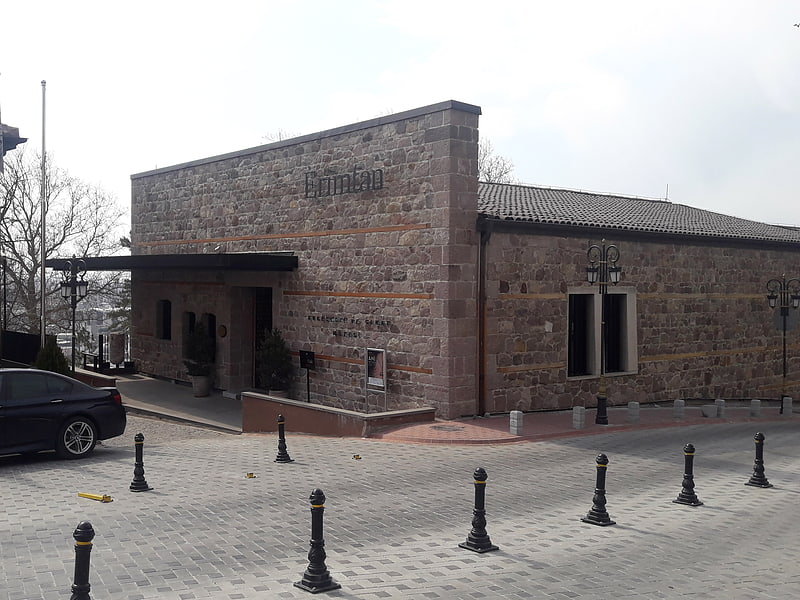
Museum in Ankara, Turkey. Erimtan Archaeology and Arts Museum is an archaeology museum and music venue in Ankara, Turkey.[7]
Selimiye Mosque, Edirne
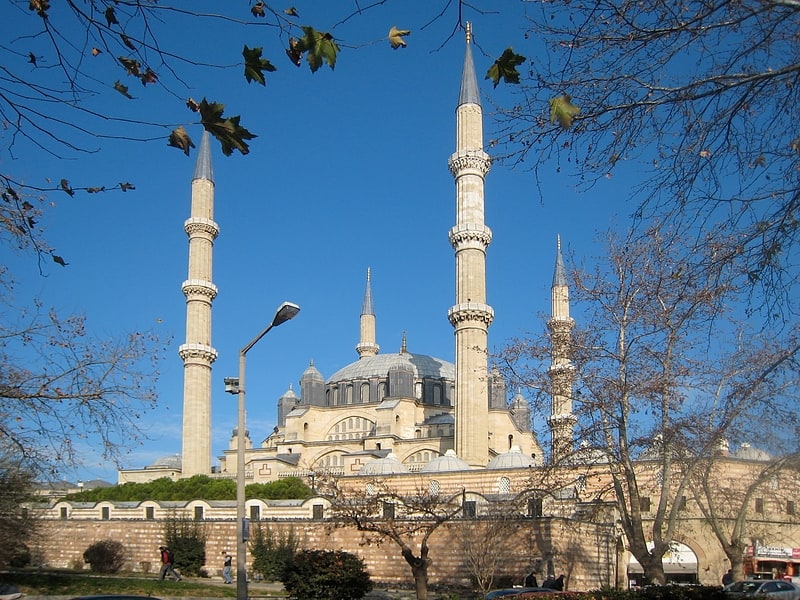
Also known as: Selimiye Camii
Stunning 16th-century Ottoman mosque. The Selimiye Mosque is an Ottoman imperial mosque, which is located in the city of Edirne, Turkey. The mosque was commissioned by Sultan Selim II, and was built by the imperial architect Mimar Sinan between 1568 and 1575. It was considered by Sinan to be his masterpiece and is one of the highest achievements of Islamic architecture as a whole and Ottoman architecture in particular.
It was added as a UNESCO World Heritage Site in 2011.[8]
Address: Meydan Mahallesi, Mimar Sinan Cd., 22020 Edirne Merkez
Karagoz Museum, Bursa
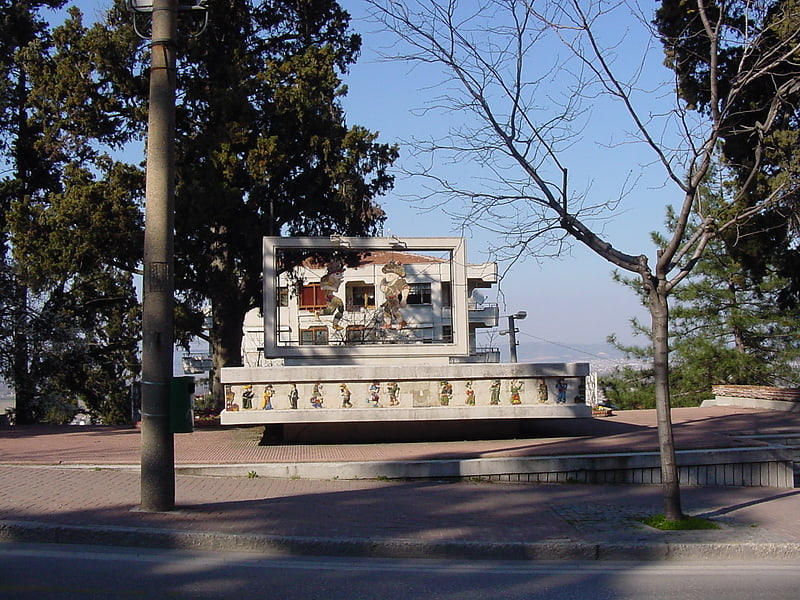
Bursa Karagöz Museum is a museum located at Osmangazi in Bursa, northwestern Turkey, dedicated to the folkloric shadow play figures Karagöz and Hacivat. It was established in 2007.[9]
Address: Çekirge Mah. Çekirge Cad. No:159, 16070 Osmangazi
Atatürk's House Museum, Antalya
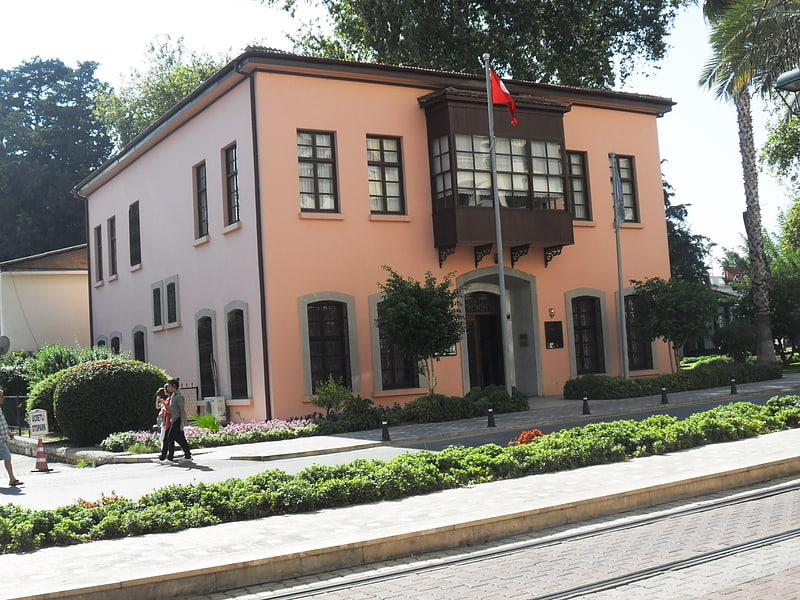
Museum in Antalya, Turkey. Atatürk's House Museum) is a national museum in Antalya, Turkey dedicated to the visits of Mustafa Kemal Atatürk to this city.[10]
Address: Antalya Muratpaşa, Antalya
Antalya Museum, Antalya

Also known as: Antalya Müzesi
Anatolia from prehistory to the present. The Antalya Museum or Antalya Archeological Museum is one of Turkey's largest museums, located in Konyaaltı, Antalya. It includes 13 exhibition halls and an open air gallery. It covers an area of 7,000 m2 and 5000 works of art are exhibited. In addition a further 25,000–30,000 artifacts which cannot be displayed are in storage. As a museum exhibiting examples of works, which illuminate the history of the Mediterranean and Pamphylia regions in Anatolia, Antalya Museum is one of the most important of Turkey's museums. The Museum won the “European Council Special Prize” in 1988.[11]
Address: Konyaalti Cad. No: 88, 07050 Antalya
Ulu Cami, Bursa

Massive, intricate 14th-century mosque. The Grand Mosque of Bursa is a historic mosque in Bursa, Turkey. It was commissioned by the Ottoman Sultan Bayezid I to commemorate his great victory at the Battle of Nicopolis and built between 1396 and 1399. The mosque is a major monument of early Ottoman architecture and one of the most important mosques in the city, located in the heart of the old city alongside its historic markets.[12]
Address: Nalbantoğlu Mahallesi, 16010 Osmangazi
Koza Han, Bursa
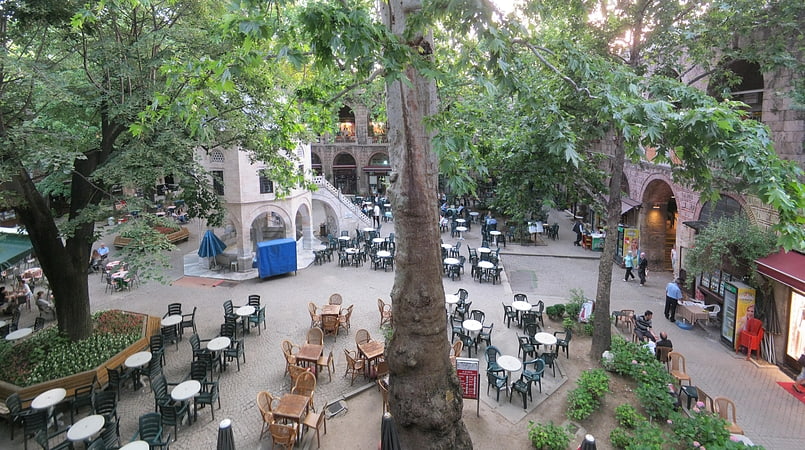
Caravanserai in Bursa, Turkey. The Koza Han is a historic caravanserai in Bursa, Turkey. It is located in the heart of the city's historic market district.[13]
Kızıl Kule, Alanya
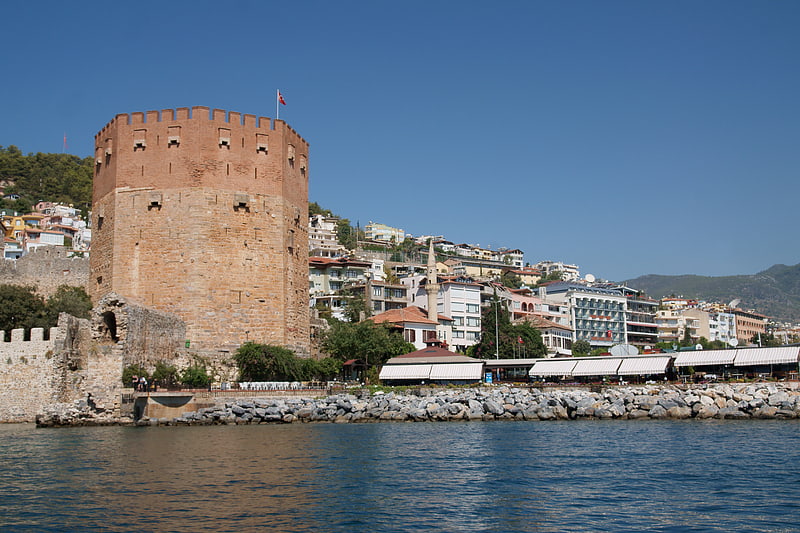
Also known as: Kızılkule
Famous tower with an ethnographic museum. The Kızıl Kule is a historical tower in the Turkish city of Alanya. The building is considered to be the symbol of the city, and is used on the city's flag.[14]
Hagia Sophia, Trabzon

Also known as: Trabzon Ayasofya Müzesi
Museum in Trabzon, Turkey. Hagia Sophia is a formerly Greek Orthodox church which was converted into a mosque in 1584, and located in Trabzon, in the north-eastern part of Turkey. It was converted into a museum in 1964 and back into a mosque in 2013. It dates back to the thirteenth century when Trabzon was the capital of the Empire of Trebizond. It is located near the seashore and two miles west of the medieval town's limits. It is one of a few dozen Byzantine sites extant in the area. It has been described as being "regarded as one of the finest examples of Byzantine architecture."[15]
Address: Fatih Mahallesi, 61040 Ortahisar
Mevlana Museum, Konya
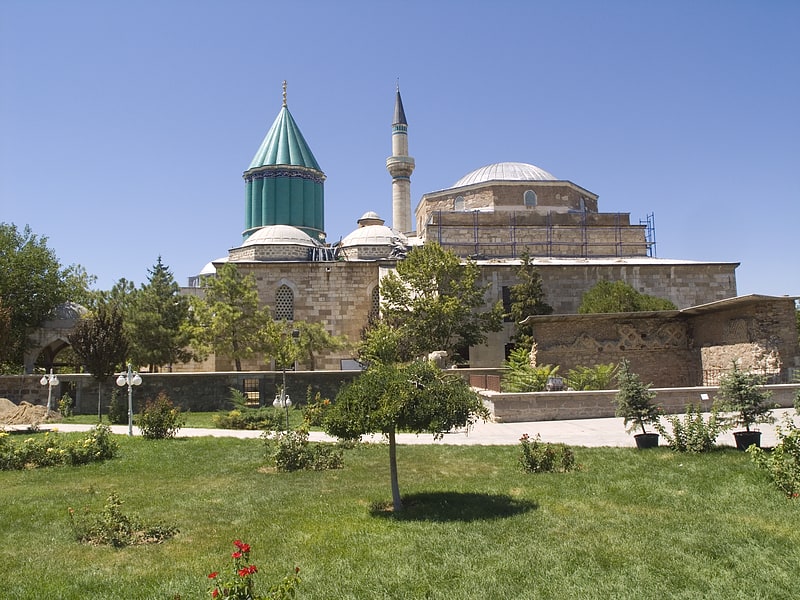
Also known as: Mevlânâ Müzesi
Historic mausoleum and dervish museum. The Mevlâna Museum, located in Konya, Turkey, is the mausoleum of Jalal ad-Din Muhammad Rumi, a Persian Sufi mystic. It was also the dervish lodge of the Mevlevi order, better known as the whirling dervishes.
Sultan 'Ala' al-Din Kayqubad, the Seljuk sultan who had invited Mevlâna to Konya, offered his rose garden as a fitting place to bury Rumi's father, Baha' ud-Din Walad (also written as Bahaeddin Veled), when he died on 12 January 1231. When Mevlâna died on 17 December 1273 he was buried next to his father.
Mevlâna's successor Hüsamettin Çelebi decided to build a mausoleum (Kubbe-i-Hadra) over the grave of his master. The Seljuk construction, under architect Badr al-Din Tabrizi, was finished in 1274. Gurju Khatun, the wife of the Seljuk Emir Suleiman Pervâne, and Emir Alameddin Kayser funded the construction. The cylindrical drum of the dome originally rested on four pillars. The conical dome is covered with turquoise faience.
However several sections were added until 1854. Selimoğlu Abdülvahit decorated the interior and performed the woodcarving of the catafalques.
The decree of 6 April 1926 confirmed that the mausoleum and the dervish lodge (Dergah) were to be turned into a museum. The museum opened on 2 March 1927. In 1954 it was renamed as "Mevlâna Museum".
One enters the museum through the main gate (Devisan Kapısı) to the marble-paved courtyard. The kitchen of the dervishes (Matbah) and the Hurrem Pasha tomb, built during the reign of Süleyman the Magnificent, are located on the right side. On the left side are 17 dervish cells lined up, covered with small domes, and built during the reign of Murad III. The kitchen was also used for educating the dervishes, teaching them the Sema. The ṣadirvan (washing fountain) in the middle of the courtyard was built by Yavuz Sultan Selim.
One enters the mausoleum and the small mosque through the Tomb gate (Türbe Kapisi). Its two doors are decorated with Seljuk motifs and a Persian text from mollah Abdurrahman Cami dating from 1492. It leads into the small Tilavet Room (Tilavet Odası) decorated with rare and precious Ottoman calligraphy in the sülüs, nesih, and talik styles. In this room the Koran was continuously recited and chanted before the mausoleum was turned into a museum.
One enters the mausoleum from the Tilavet Room through a silver door made, according to an inscription on the door, by the son of Mehmed III in 1599. On the left side stand six coffins in rows of three of the dervishes (Horasan erler) who accompanied Mevlâna and his family from Belkh. Opposite to them on a raised platform, covered by two domes, stand the cenotaphs belonging to the descendants of the Mevlâna family (wife and children) and some high-ranking members of the Mevlevi order.
The sarcophagus of Mevlâna is located under the green dome (Kibab'ulaktab). It is covered with brocade, embroidered in gold with verses from the Koran. This, and all other covers, were a gift of sultan Abdul Hamid II in 1894. The actual burial chamber is located below it. Next to Mevlâna's sarcophagus are several others, including the sarcophagi of his father Bahaeddin Veled and his son Sultan Veled. The wooden sarcophagus of Mevlâna dates from the 12th century now stands over the grave of his father. It is a masterpiece of Seljuk woodcarving. The silver lattice, separating the sarcophagi from the main section, was built by Ilyas in 1579.
The Ritual Hall (Semahane) was built under the reign of Süleyman the Magnificent at the same time as the adjoining small mosque. In this hall the dervishes used to perform the Sema, the ritual dance, on the rhythm of musical instruments such as, the kemence (a small violin with three strings), the keman (a larger violin), the halile (a small cymbal), the daire (a kind of tambourine), the kudüm (a drum), the rebab (a guitar) and the flute, played once by Mevlâna himself. All these instruments are on display in this room, together with an ancient Kirşehir praying rug (18th century), dervish clothes (Mevlâna's included) and four crystal mosque lamps (16th century, Egyptian Mameluk period). In this room one can also see a rare Divan-i-Kebir (a collection of lyric poetry) from 1366 and two fine specimens of Masnavis (books of poems written by Mevlâna) from 1278 and 1371.
The adjoining small mosque (Masjid) is now used for the exhibition of a collection of old, illustrated Korans and extremely valuable prayer rugs. There is also a box (Sakal-i Ṣerif), decorated with nacre, containing the Holy Beard of Muhammad.
The mausoleum was depicted on the reverse of the Turkish 5000 lira banknotes of 1981–1994. It received 2.5 million visitors in 2017, making it Turkey's most visited museum that year.[16]
Address: Aziziye Mah, Mevlana Cd. No:1, 42030 Karatay
House of the Virgin Mary, Selçuk
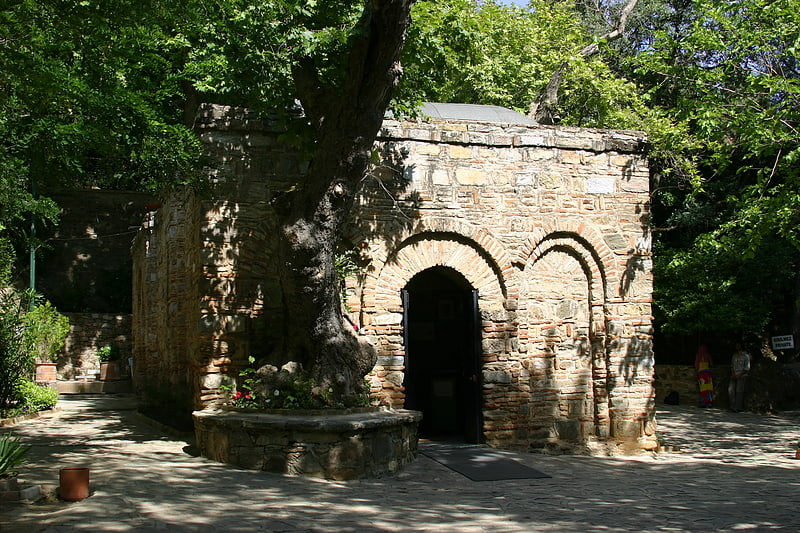
Also known as: Meryem Ana Evi
Site of former home of the Virgin Mary. The House of the Virgin Mary is a Catholic shrine located on Mt. Koressos in the vicinity of Ephesus, 7 kilometres from Selçuk in Turkey.
The house was discovered in the 19th century by following the descriptions in the reported visions of Blessed Anne Catherine Emmerich (1774–1824), a Roman Catholic nun and visionary, which were published as a book by Clemens Brentano after her death. While the Catholic Church has never pronounced in favour or against the authenticity of the house, the site has nevertheless received a steady flow of pilgrimage since its discovery. Anne Catherine Emmerich was beatified by Pope John Paul II on October 3, 2004.
Catholic pilgrims visit the house based on the belief that Mary, the mother of Jesus, was taken to this stone house by Saint John and lived there for the remainder of her earthly life.
The shrine has merited several papal Apostolic Blessings and visits from several popes including Paul VI, John Paul II, and Benedict XVI.[17]
Address: Acarlar Mahallesi, Meryem Ana Yolu, 35920 Selçuk
Agora of Smyrna, Izmir

The Agora of Smyrna, alternatively known as the Agora of İzmir, is an ancient Roman agora located in Smyrna. Originally built by the Greeks in the 4th century BC, the agora was ruined by an earthquake in 178 AD. Roman Emperor Marcus Aurelius ordered its reconstruction. Excavations started in 1933. In 2020, the Agora of Smyrna became a Tentative World Heritage Site as part of "The Historical Port City of Izmir."[18]
Address: Namazgah Mahallesi, Tarık Sarı Sk. No:29, 35240 Konak
Antique Theatre, Bodrum
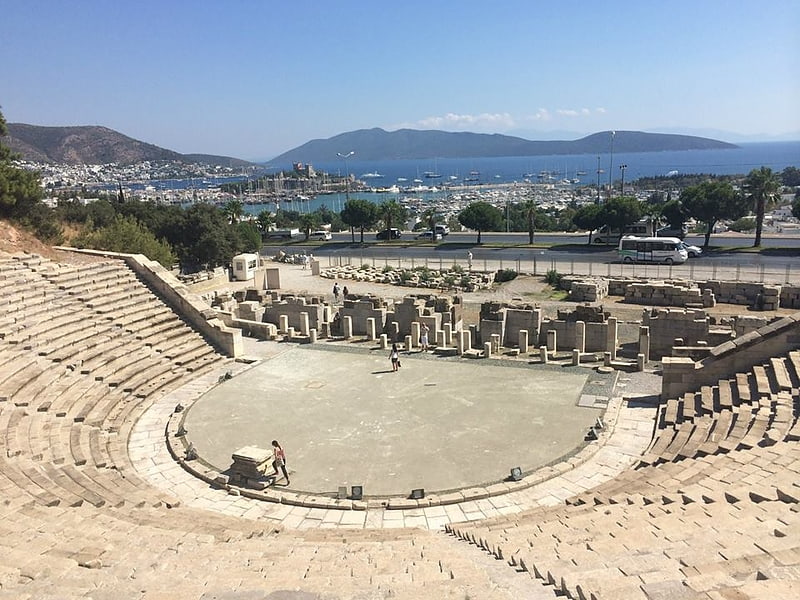
The Theatre at Halicarnassus, also known as Bodrum Antique Theatre, is a 4th-century BC Greco-Roman theatre located in Bodrum, Turkey. The theatre is considered to be built in a similar style to Ancient Theatre of Epidaurus.[19]
Yivli Minare, Antalya
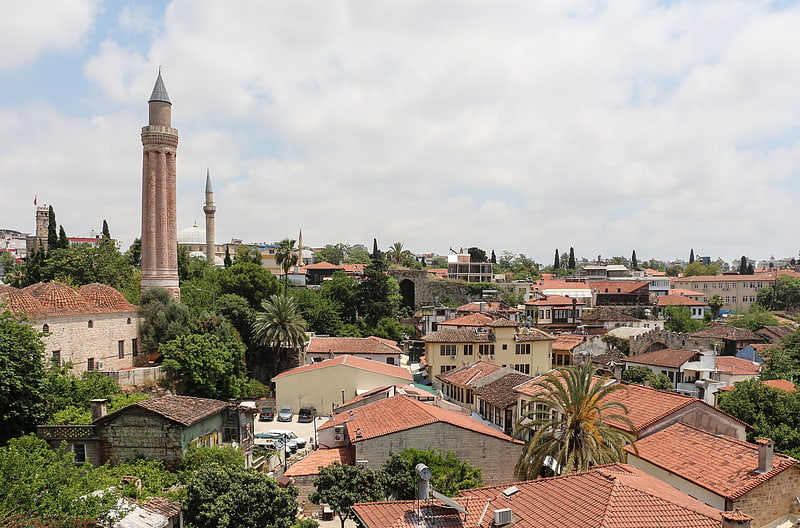
13th-century mosque with fluted minaret. The Alaaddin Mosque or Yivli Minare Mosque, commonly also called Ulu Mosque in Antalya is a historical mosque built by the Anatolian Seljuk Sultan Alaaddin Keykubad I. It is part of a külliye which includes the Gıyaseddin Keyhüsrev Medrese, Seljuk and Dervish lodge, and the vaults of Zincirkıran and Nigar Hatun. The mosque is located in Kaleiçi along Cumhuriyet Caddesi, next to Kalekapısı Meydanı. The mosque's fluted minaret called the Yivli Minare, which is decorated with dark blue tiles, is a landmark and symbol of the city. In 2016 it was inscribed in the Tentative list of World Heritage Sites in Turkey.[20]
Address: Selçuk Mh. İskele Cd., Antalya
Sabancı Central Mosque, Adana
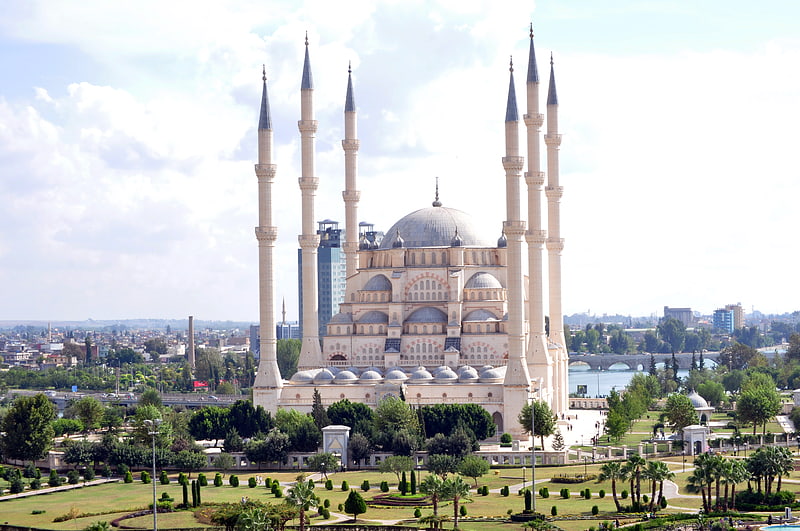
Also known as: Sabancı Merkez Camii
Grand riverside mosque with 6 minarets. Sabancı Merkez Camii in Adana is the second largest mosque in Turkey. The exterior of the mosque is similar to the Selimiye Mosque in Edirne, though it has six minarets, similar to the Sultan Ahmed Mosque in Istanbul.
The mosque, which went into service in 1998, was constructed upon a confiscated Armenian cemetery. It is built on a total of 52,600 square metres (566,000 square feet) of land and has a closed area of 6,600 square metres (71,000 square feet).
Sabancı Central Mosque was built jointly by Turkish Religious Foundation and Sabanci Foundation. The proprietorship of the mosque belongs to Adana Religious Affairs Foundation and its usage rights have been transferred to Adana Provincial Office of Mufti.[21]
Address: Reşatbey Mh. Girne Blv., 01120 Seyhan
Temple of Artemis, Selçuk

Also known as: Artemis Tapınağı
Archaeological ruins of a Greek temple. The Temple of Artemis or Artemision, also known as the Temple of Diana, was a Greek temple dedicated to an ancient, local form of the goddess Artemis. It was located in Ephesus. By 401 AD it had been ruined or destroyed. Only foundations and fragments of the last temple remain at the site.
The earliest version of the temple antedated the Ionic immigration by many years. Callimachus, in his Hymn to Artemis, attributed it to the Amazons. In the 7th century BC, it was destroyed by a flood. Its reconstruction, in more grandiose form, began around 550 BC, under Chersiphron, the Cretan architect, and his son Metagenes. The project was funded by Croesus of Lydia, and took 10 years to complete. This version of the temple was destroyed in 356 BC by Herostratus in an act of arson.
The next, greatest, and last form of the temple, funded by the Ephesians themselves, is described in Antipater of Sidon's list of the world's Seven Wonders:
I have set eyes on the wall of lofty Babylon on which is a road for chariots, and the statue of Zeus by the Alpheus, and the hanging gardens, and the colossus of the Sun, and the huge labour of the high pyramids, and the vast tomb of Mausolus; but when I saw the house of Artemis that mounted to the clouds, those other marvels lost their brilliancy, and I said, "Lo, apart from Olympus, the Sun never looked on aught so grand".[22]
Konak Square, Izmir

Also known as: Konak Meydanı
Historical landmark in Konak, Turkey. Konak Square is a busy square at the southern end of Atatürk Avenue in the Konak district of İzmir, Turkey. The square is the busiest part of the city, as Konak is the main place of İzmir. The square is named after the Vali Konağı of İzmir Province, which is located here[23]
Alanya Castle, Alanya
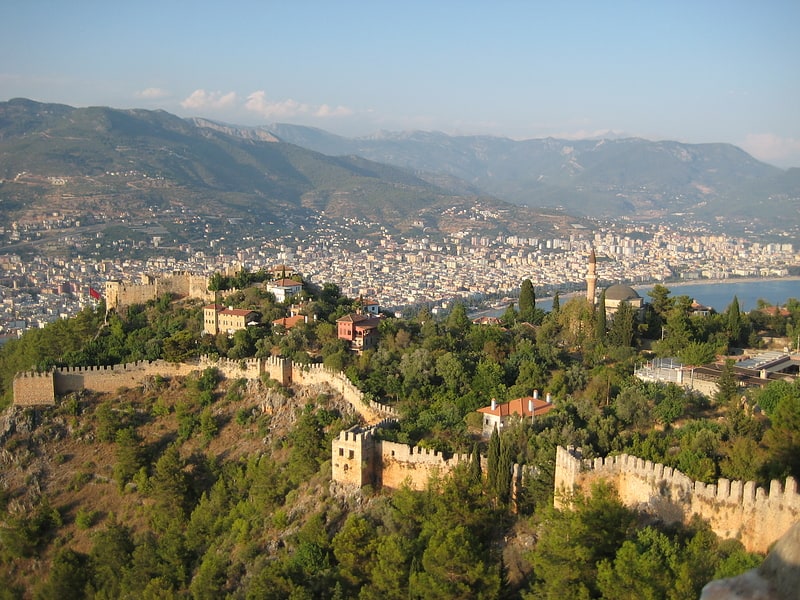
Also known as: Alanya Kalesi
Seljuk-period castle and red tower. Alanya Castle is a medieval castle in the southern Turkish city of Alanya.[24]
Alâeddin Mosque, Konya
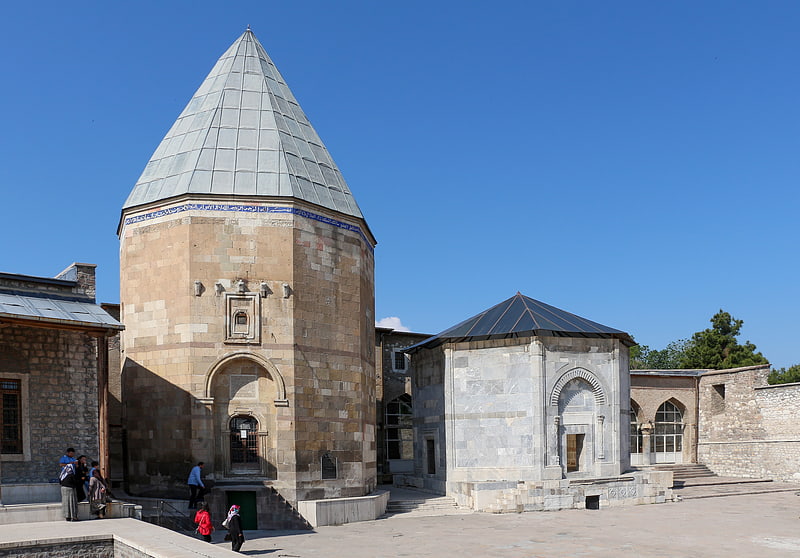
Also known as: Alâeddin Camii, Konya
Mosque in Konya, Turkey. The Alâeddin Mosque is the principal monument on the citadel of Konya, Turkey. The building served as the "Mosque of the Throne" for the Seljuq Sultans of Rum and contains the dynastic mausoleum. It was constructed in stages between the mid-12th and mid-13th centuries. Both the citadel and the mosque bear the name of sultan 'Ala al-Din Kayqubad I.[25]
Address: Alaeddin Tepesi, Konya
Yalı Mosque, Izmir
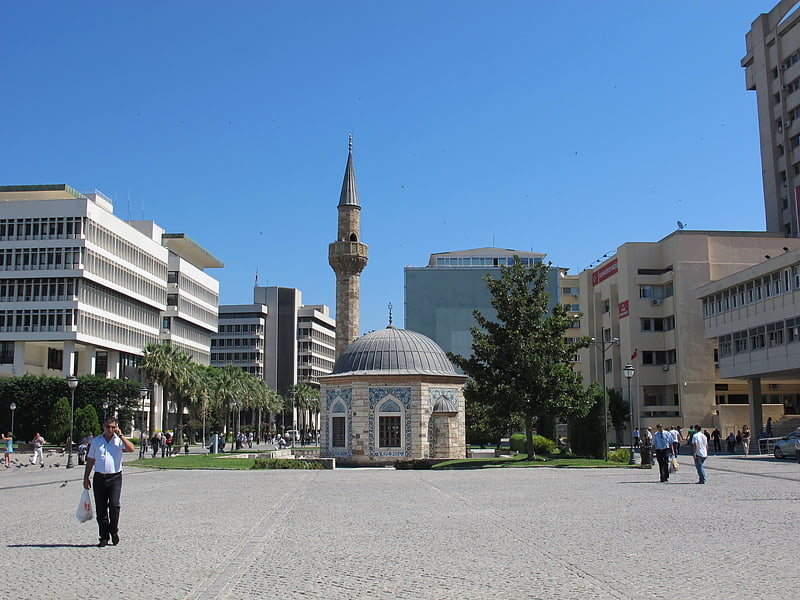
Also known as: Konak Yalı Camii
Mosque in İzmir, Turkey. Konak Mosque, also called Yalı Mosque, is a mosque in İzmir, Turkey. It is located on Konak Square in the heart of the city next to the Governor's Mansion and the İzmir Clock Tower. Despite its relatively small size, it is considered one of the landmarks of the city for its distinctive octagonal shape and elaborate tilework.
The Mosque was constructed in 1755 under the patronage of Ayşe Hanım, the wife of Katipzade Mehmet Paşa who governed İzmir at the time. The outer tiles were brought from Kütahya. It has a single dome and minaret and unusually for a mosque, only one entrance. The interior is lit by a chandelier by Ümran Baradan.[26]
Ince Minaret Medrese, Konya
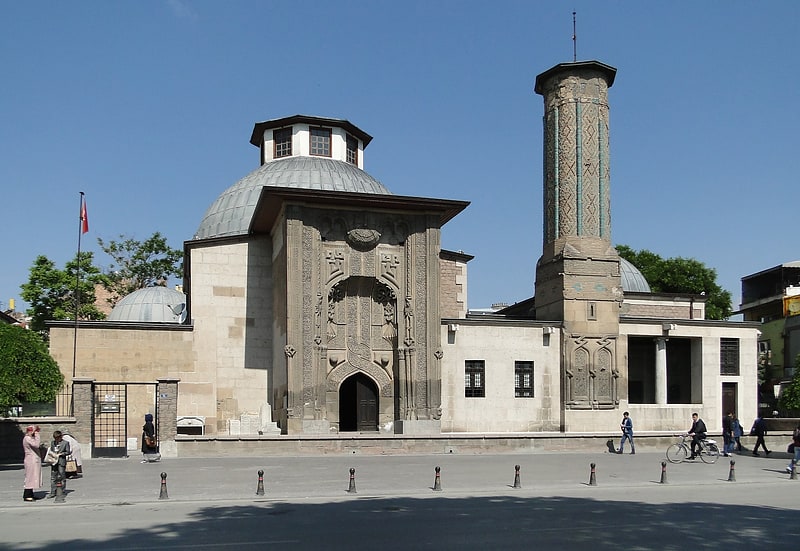
Also known as: İnce Minareli Medrese
Museum. İnce Minareli Medrese is a 13th-century madrasa located in Konya, Turkey, now housing the Museum of Stone and Wood Art, noted for its ornate entrance, domed courtyard, ornamentally bricked minaret, partially destroyed in 1901, and exemplar Anatolian Seljuk architecture.[27]
Address: Hamidiye Mah. Alaaddin Bulv. No:15 Meram Merkez, Meram, Konya
Ramazanoglu Mosque, Adana
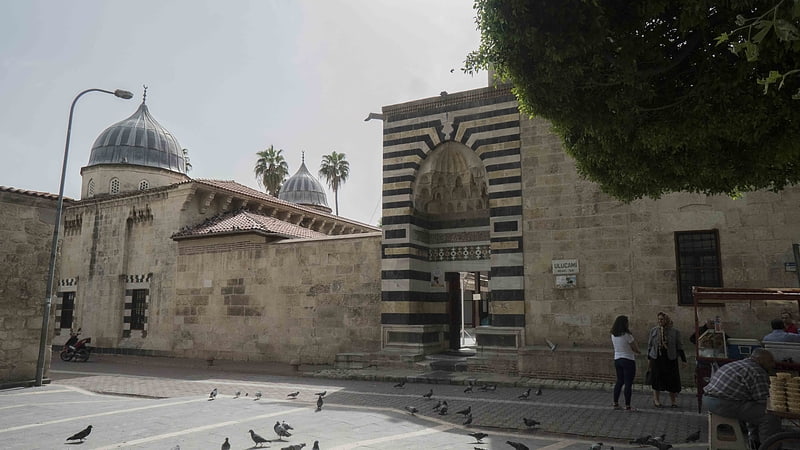
Also known as: Adana Ulu Camii
Mosque in Adana, Turkey. Ulu Cami, is a 16th-century mosque in Adana, Turkey. It forms part of a complex that includes a madrasah and a mausoleum. The buildings are on Kızılay street, next to the Ramazanoğlu Hall.[28]
Address: Ulucami Mh. Kızılay Cd. 25005. Sk, 01010 Seyhan
Marmaris Castle, Marmaris
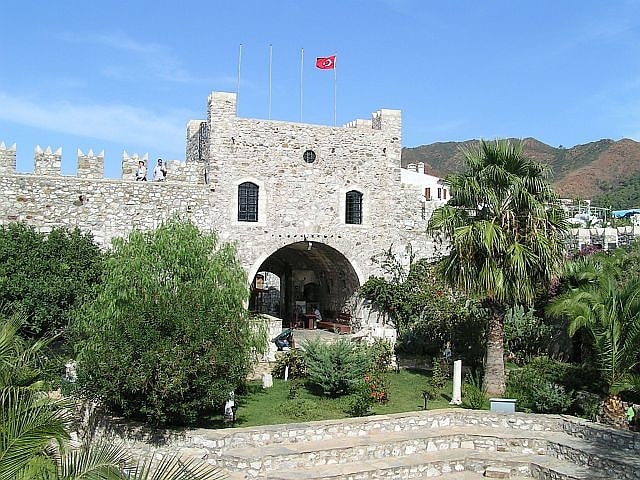
Also known as: Marmaris Kalesi
Museum in Marmaris, Turkey. Marmaris Castle is located in Muğla province, Turkey. The castle was reconstructed by Süleyman the Magnificent during his expedition against Rhodes.
The Marmaris Castle is one of the few castles in Turkey that also possesses a museum.
According to Greek historian Herodotus, the first city walls in Marmaris were constructed in 3,000 BC, although the only written source about the construction of the castle by the renowned Ottoman traveler, Evliya Çelebi, in his work Seyahatname.
Çelebi, who visited Muğla and its vicinity in the 17th century, says Sultan Süleyman ordered the construction of the castle before his expedition to Rhodes and that the castle served as a military base during the expedition.
An important part of the castle was destroyed during World War I by a French warship. Until 1979, locals of Marmaris inhabited the castle, which is known to include 18 residences, a fountain and a cistern.
The castle was registered as a monumental structure in 1983 and opened as a museum in 1991.[29]
Address: Tepe mah, Marmaris
Kazdağlı Mosque, Safranbolu
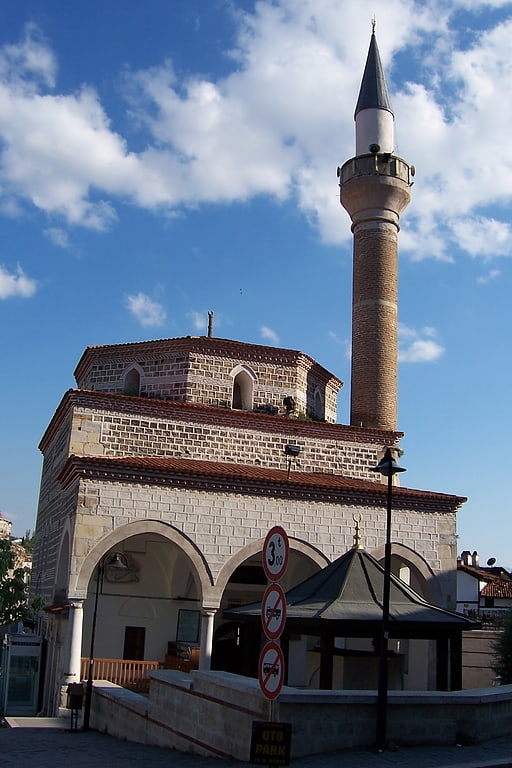
Kazdağlı Mosque is a historical mosque located in Safranbolu, Turkey.[30]
Old Mosque, Edirne
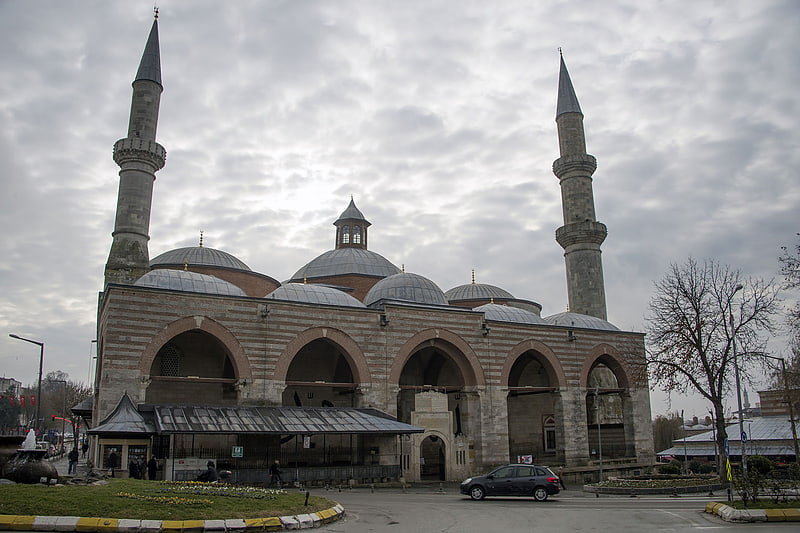
Also known as: Eski Cami
Ottoman mosque dating back to 1414. The Old Mosque, also known as Grand Mosque, is an early 15th-century Ottoman mosque in Edirne, Turkey.[31]
Address: Sabuni Mah. Talat Paşa Cad., Edirne
Mor Hananyo Monastery, Mardin
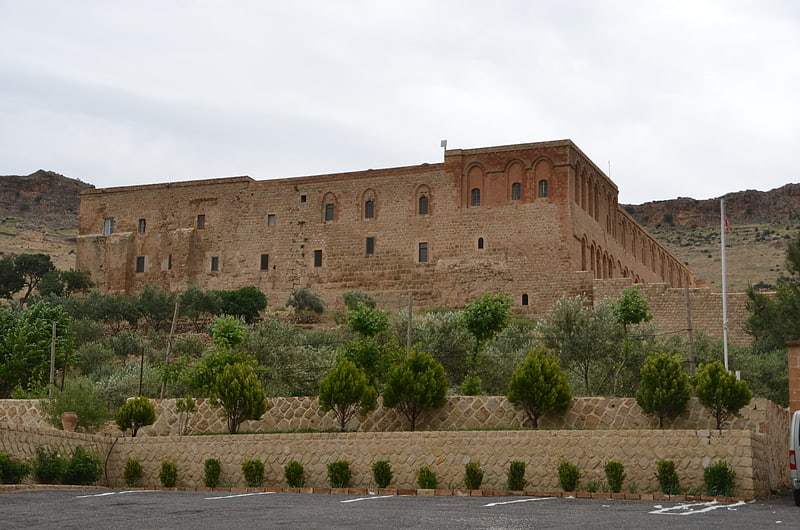
Also known as: Deyrüzzaferân Manastırı
Monastery in Turkey. Dayro d-Mor Hananyo is an important Syriac Orthodox monastery. The monastery is located in the Syriac cultural region known as Tur Abdin, and is located three kilometers south east of Mardin, Turkey.
It is usually better known by its nickname, the "Saffron Monastery" (Syriac: ܕܝܪܐ ܕܟܘܪܟܡܐ, Dairo d-Kurkmo; Arabic: دير الزعفران, Dairu 'l-Za‘farān) which is derived from the warm color of its stone. Syriac Orthodox culture was centered in two monasteries near Mardin (west of Tur Abdin), Mor Gabriel and Deyrulzafaran.[32]
Address: Merkez Mardin Merkez, Mardin Merkez, Mardin
Library of Pergamum, Bergama
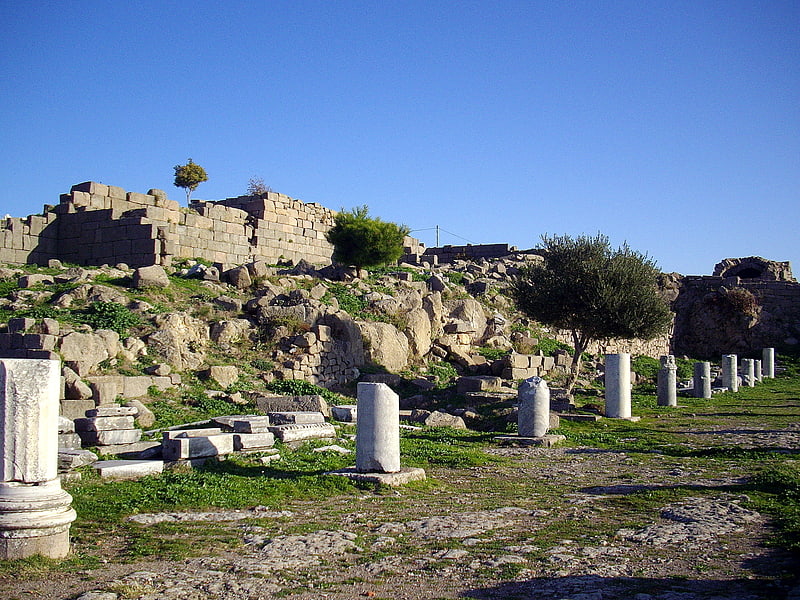
The Library of Pergamum in Pergamum, Turkey, was one of the most important libraries in the ancient world.[33]
Merkez Park, Adana
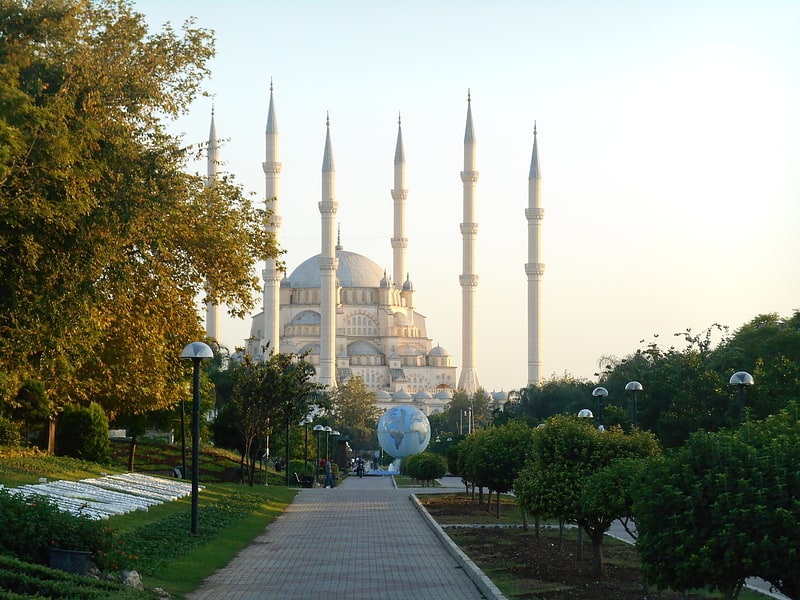
Park in Adana, Turkey. Merkez Park is a 33-hectare urban park that is located on both banks of the Seyhan River in Adana. The larger portion of the park, 30 hectares, is on the west bank.
Merkez Park starts just north of Sabancı Mosque and extends north to Galleria Shopping Mall. On the west of the park there is Fuzuli Street. On the east bank, the park starts north of the Sheraton Hotel (under construction) and extends north to the Acqualand Entertainment Center. On the east, the park is bordered with Hacı Sabancı Boulevard. Sinanpaşa and Yavuzlar footbridges connect both sections of the park.[34]
İsa Bey Camii, Selçuk
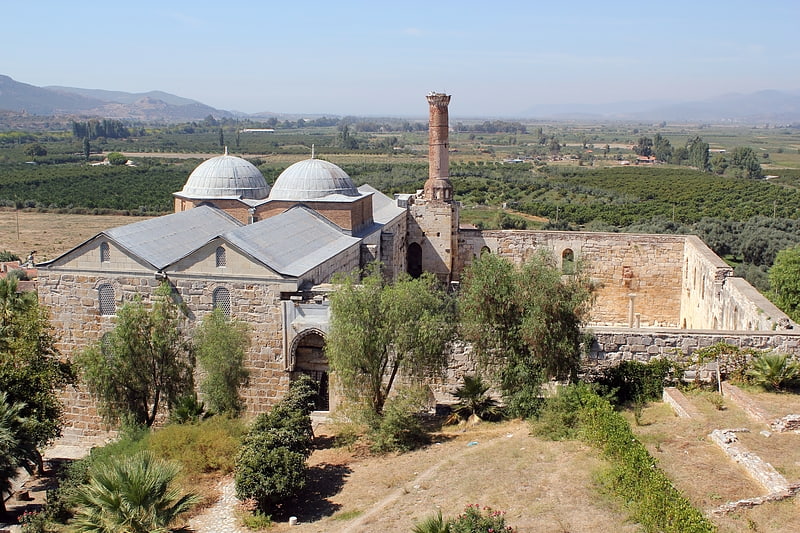
14th-century mosque. The İsa Bey Mosque, constructed in 1374–75, is one of the oldest and most impressive works of architectural art remaining from the Anatolian beyliks. The mosque is situated on the outskirts of the Ayasluğ Hills at Selçuk, İzmir.[35]
Address: İsa Bey Mh. 2040. Sk., Selçuk
Gaziantep Zoo, Gaziantep
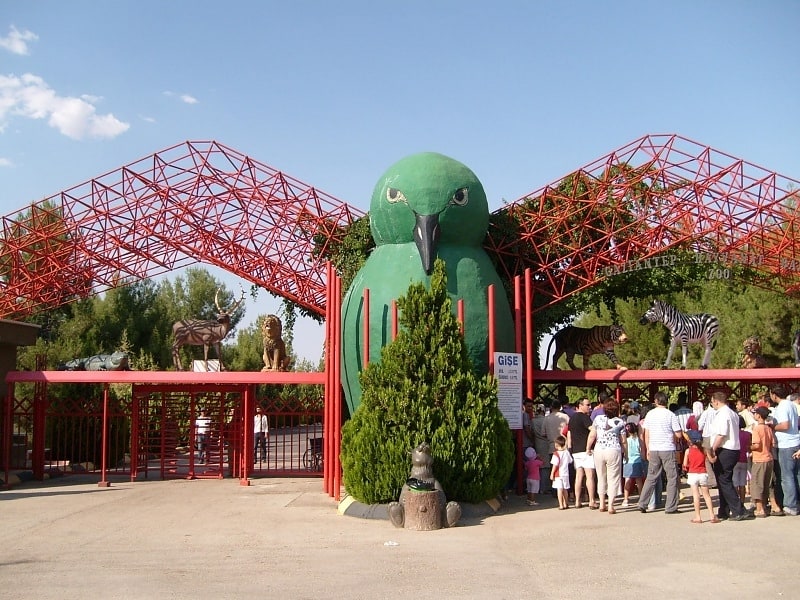
Gaziantep Zoo is a zoo in Gaziantep, Turkey[36]
Kalepark, Trabzon
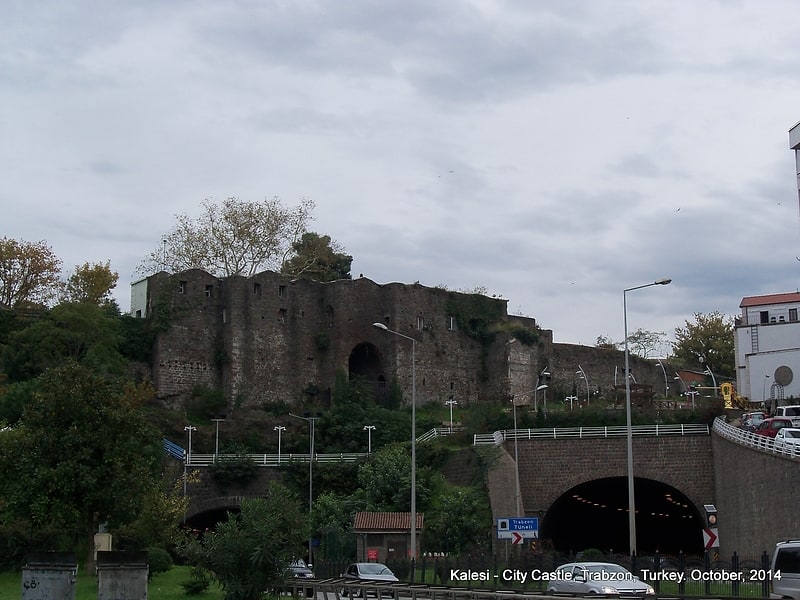
Kalepark was procured and further fortified by Genoese merchants as a medieval fortress on the east side of Trabzon, Turkey. The fortress was built on a rocky outcrop strategically overlooking both harbors of the city: the summer harbor at a distance to the west, and the winter harbor just to the east of it. A few hundred meters to the west of Leonkastron lay the "Venetian Castle", which was a competing fortified trading outpost. In the following centuries many other Europeans settled on the streets between these forts - such as traders from Lviv in Ukraine - and it thus became known as the "European quarter".
In the 1740s, a palace was built for the Ottoman Governor Ahmet Paşa at the same location, which was destroyed by a fire in 1790.
The castle was frequently shelled during World War I by the Russian naval forces, due to its easily accessible location near the Black Sea coast.[37]
Edirne Palace, Edirne
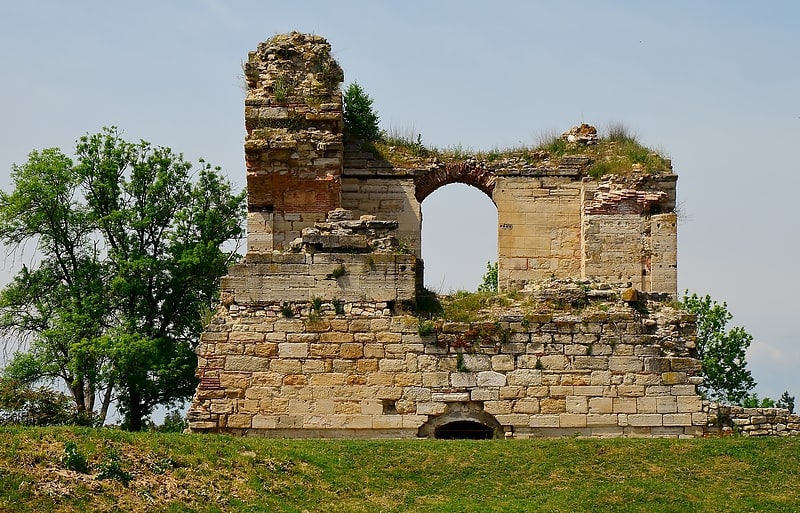
Also known as: Edirne Sarayı
Palace in Turkey. Edirne Palace, or formerly New Imperial Palace is a former a palace of the Ottoman sultans in Edirne, mostly during the era when the city was the capital of the empire. Few of the palace buildings have survived until now, however works are underway for its reconstruction.[38]
Address: Edirne, Sarayiçi
Asclepeion, Bergama
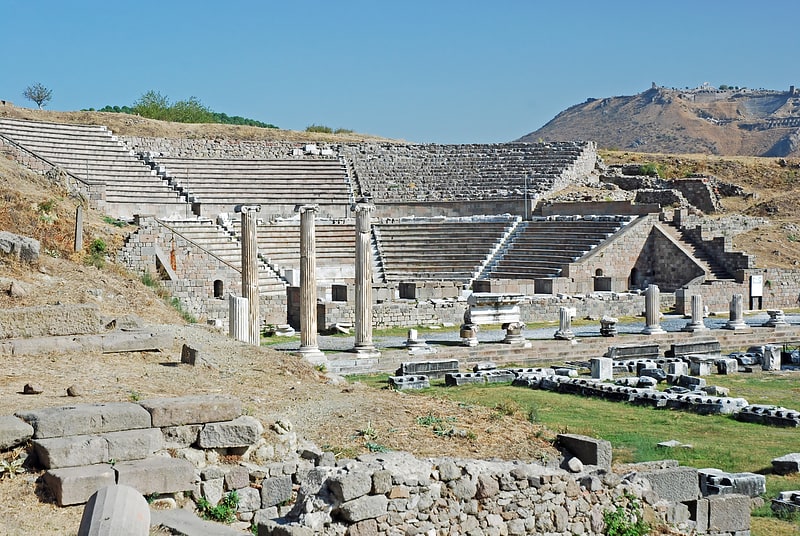
Also known as: Asklepion
Asclepeions were healing temples located in ancient Greece, dedicated to Asclepius, the first doctor-demigod in Greek mythology. Asclepius was said to have been such a skilled doctor that he could even raise people from the dead. So stemming from the myth of his great healing powers, pilgrims would flock to temples built in his honor in order to seek spiritual and physical healing.
Asclepeions included carefully controlled spaces conducive to healing and fulfilled several of the requirements of institutions created for healing. Treatment at these temples largely centered around promoting healthy lifestyles, with a particular emphasis on a person's spiritual needs. Characteristic of the Asclepeion was the practice of incubatio, also known as 'temple sleep.' This was a process by which patients would go to sleep in the temple with the expectation that they would be visited by Asclepius himself or one of his healing children in their dream. During this time, they would be told what it is that they needed to do in order to cure their ailment. At the very least, they would wake up having not been directly visited by a deity and instead report their dream to a priest. The priest would then interpret the dream and prescribe a cure, often a visit to the baths or a gymnasium. The preliminary treatment for admission into the Asclepions was catharsis, or purification. It consisted of a series of cleansing baths and purgations, accompanied by a cleansing diet, which lasted several days.
Despite these methods being regarded as ‘faith healing,’ they were highly effective, as is evident by the numerous written accounts by patients attesting to their healing and providing detailed accounts of their cure. In the Asclepeion of Epidaurus, three large marble boards dated to 350 BC preserve the names, case histories, complaints, and cures of about 70 patients who came to the temple with a problem and shed it there. Some of the surgical cures listed, such as the opening of an abdominal abscess or the removal of traumatic foreign material, are realistic enough to have taken place, with the patient in a dream-like state of induced sleep known as "enkoimesis" (Greek: ἐγκοίμησις), not unlike anesthesia, induced with the help of soporific substances such as opium.
Asclepeions also became home to future physicians as well. Hippocrates is said to have received his medical training at an asclepeion on the isle of Kos. Prior to becoming the personal physician to the Roman Emperor Marcus Aurelius, Galen treated and studied at the famed asclepeion at Pergamon.[39]
Trabzon Museum, Trabzon

Also known as: Trabzon Müzesi
Regional artifacts in a 1900s mansion. The Trabzon Museum, also known as Kostaki Mansion, is a historic house museum with archeological and ethnographic exhibitions located in Trabzon, Turkey.[40]
Address: Gazipaşa Mahallesi, Zeytinlik Cd. No:7, 61030 Trabzon Merkez
Göbekli Tepe, Urfa
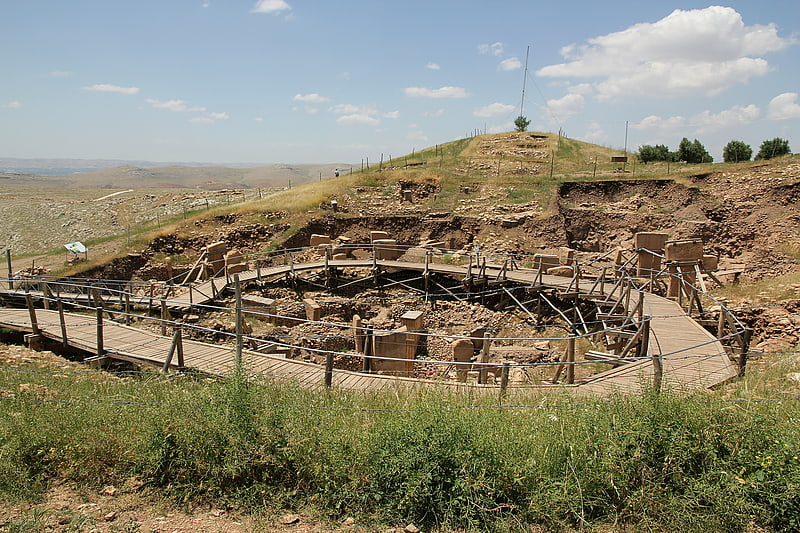
Also known as: Göbeklitepe
Historical landmark in Turkey. Göbekli Tepe is a Neolithic archaeological site near the city of Şanlıurfa in Southeastern Anatolia, Turkey. Dated to the Pre-Pottery Neolithic, between c. 9500 and 8000 BCE, the site comprises a number of large circular structures supported by massive stone pillars – the world's oldest known megaliths. Many of these pillars are richly decorated with abstract anthropomorphic details, clothing, and reliefs of wild animals, providing archaeologists rare insights into prehistoric religion and the particular iconography of the period. The 15 m -high, 8 ha tell also includes many smaller rectangular buildings, quarries, and stone-cut cisterns from the Neolithic, as well as some traces of activity from later periods.
The site was first used at the dawn of the Neolithic period, which in Southwest Asia marks the appearance of the oldest permanent human settlements anywhere in the world. Prehistorians link this Neolithic Revolution to the advent of agriculture, but disagree on whether farming caused people to settle down or vice-versa. Göbekli Tepe, a monumental complex built on the top of a rocky mountaintop, far from known sources of water and to date produced no clear evidence of agricultural cultivation, has played a prominent role in this debate. The site's original excavator, German archaeologist Klaus Schmidt, described it as the "world's first temple": a sanctuary used by groups of nomadic hunter-gatherers from a wide area, with few or no permanent inhabitants. Other archaeologists challenged this interpretation, arguing that the evidence for a lack of agriculture and a resident population was far from conclusive. Recent research has also led the current excavators of Göbekli Tepe to revise or abandon many of the conclusions underpinning Schmidt's interpretation.
First noted in a survey in 1963, the importance of the site was recognised by Schmidt, who directed excavations there from 1995 until his death in 2014. Since then, work has continued under the auspices of Istanbul University, Şanlıurfa Museum, and the German Archaeological Institute, under the overall direction of Turkish prehistorian Necmi Karul. It was designated a UNESCO World Heritage Site in 2018, recognising its outstanding universal value as "one of the first manifestations of human-made monumental architecture". As of 2021, less than 5% of the site has been excavated.[41]
Hatay Archaeology Museum, Antakya
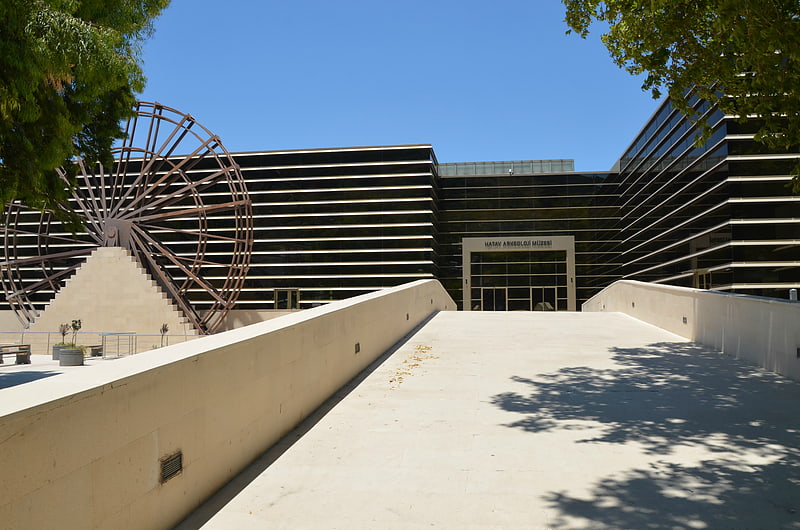
Also known as: Hatay Arkeoloji Müzesi
Museum in Turkey. The Hatay Archaeology Museum is the archaeology museum of Antakya, Turkey. It is known for its extensive collection of Roman and Byzantine Era mosaics. The museum is located in Antakya, the main city of Hatay. Construction of the museum started in 1934 on the recommendation of the French archaeologist and antiquities inspector Claude M. Prost. It was completed in 1938 and came under Turkish control in 1939 following Hatay's unification with Turkey. The museum was opened to the public in 1948 and re-opened in 1975 following renovation and expansion.[42]
Address: Cumhuriyet Mh. Gündüz Cd. 1, Antakya
Silifke Museum, Silifke
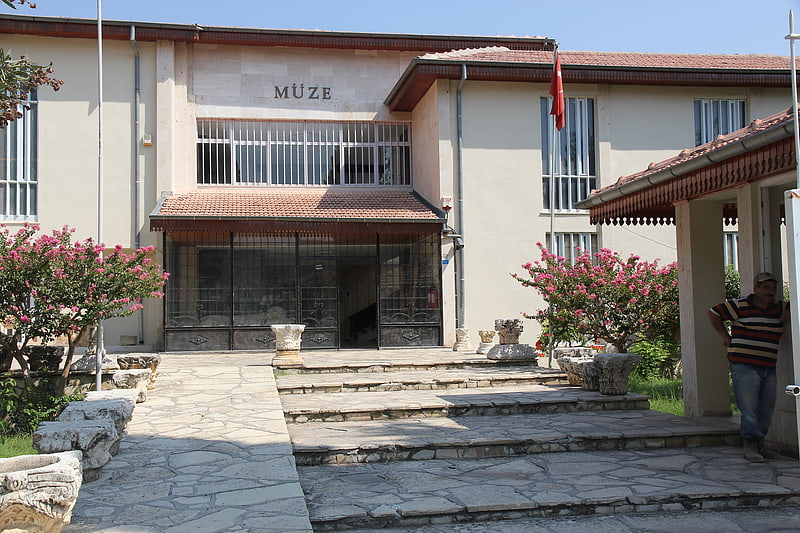
Also known as: Silifke Müzesi
Museum in Silifke, Turkey. Silifke Museum is in Silifke district of Mersin Province, Turkey.[43]
Address: Atik mh. NO: 29, 33940 Silifke
Nimara Cave, Marmaris
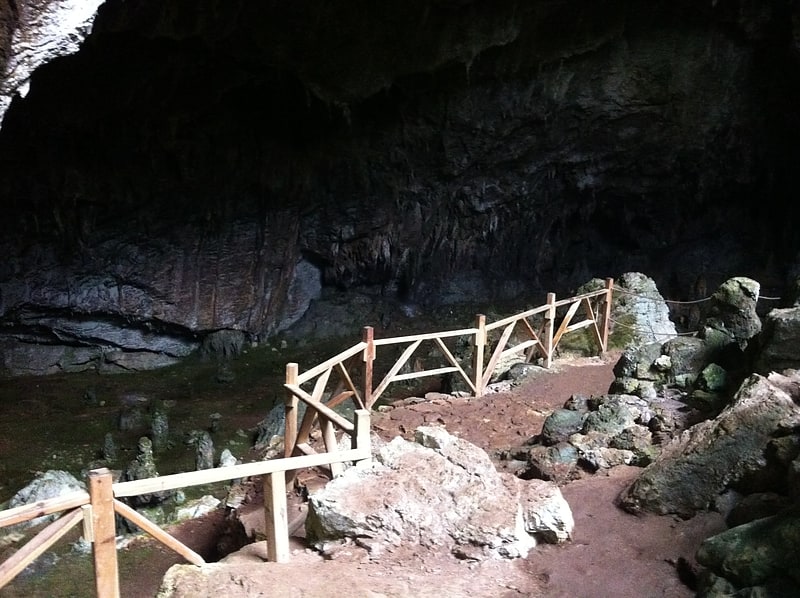
Also known as: Nimara Mağarası
Nature preserve in Turkey. Nimara Cave is a cave on Heaven Island.[44]
Alanya Archaeological Museum, Alanya

Also known as: Alanya Arkeoloji Müzesi
Museum in Alanya, Turkey. Alanya Archaeological Museum is an archaeological museum in Alanya, Turkey. The museum is divided into two sections, with displays of archaeological and ethnographic artifacts. It contains numerous ceramic, marble, bronze and glass pieces and mosaics from the Hellenistic, Roman, and Byzantine periods. Of particular note is its 2nd century bronze statue of Hercules, which measures 52 centimetres in height. The museum, which was established in 1967, was refurbished in 2012.[45]
Church of Mary, Ephesus

Also known as: Meryem Kilisesi
Cathedral in Turkey. The Church of Mary was an ancient Christian cathedral dedicated to the Theotokos, located in Ephesus. It is also known as the Church of the Councils because two councils of importance to the history of Early Christianity are assumed to have been held within. The church is located in the south stoa of the Olympieion next to the harbor of Ephesus.[46]
Myra, Demre

Also known as: Mira
Town. Myra was a Lycian, then ancient Greek, then Greco-Roman, then Byzantine Greek, then Ottoman town in Lycia, which became the small Turkish town of Kale, renamed Demre in 2005, in the present-day Antalya Province of Turkey. In 1923, its Greek inhabitants had been required to leave by the Population exchange between Greece and Turkey, at which time its church was finally abandoned. It was founded on the river Myros, in the fertile alluvial plain between Alaca Dağ, the Massikytos range and the Aegean Sea.[47]
Address: Myra Örenyeri, Demre
Hunat Hamamı, Kayseri
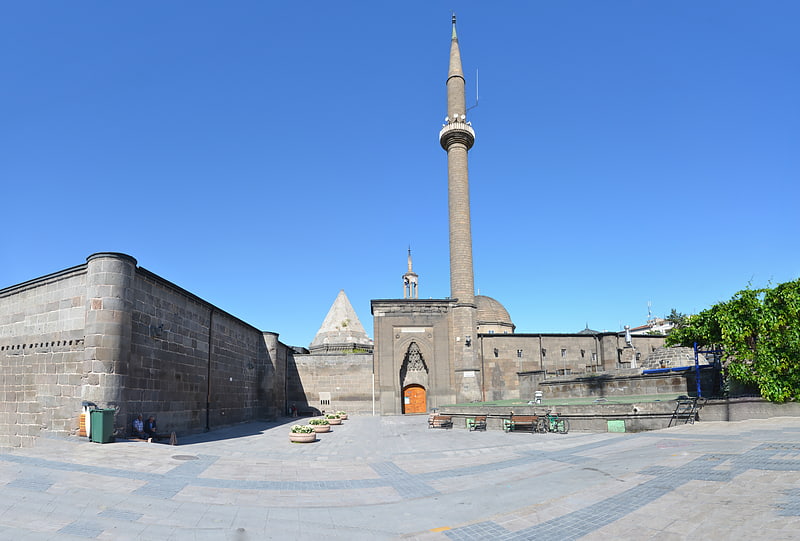
Early in the 13th century, Kayqubad I, Sultan of the Anatolian Selçuks, captured the Alanya fortress from its Armenian ruler, Kir Vart. One of the conditions of Vart’s surrender was that his daughter Hunat Mahperi Hatun would become the sultan’s wife. After her marriage, Lady Hunat converted to Islam and commissioned the Hunat Hatun Complex, made up of the Hunat Hatun Mosque, tomb, medrese, and hamam, which is still functioning and has separate facilities for men and women.
Note the complex is not in Alanya, but in Kayseri.[48]
Mardin Kalesi, Mardin
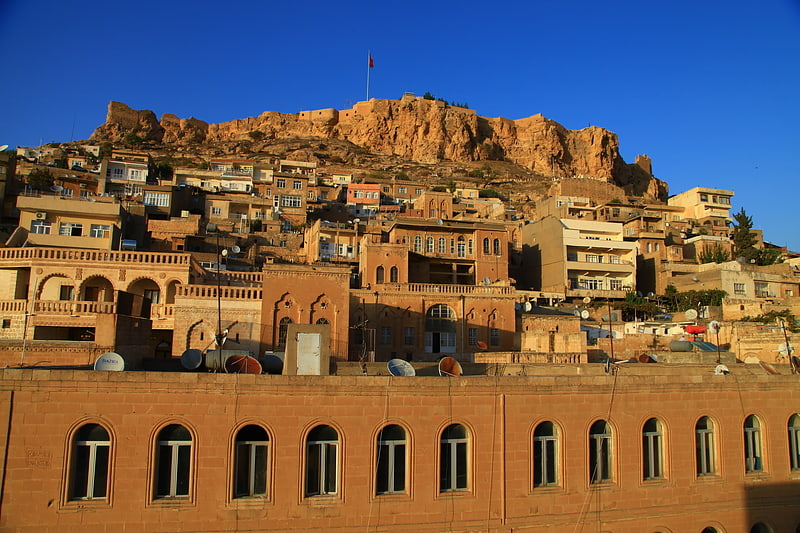
Castle in Turkey. Mardin Castle is a 3,000 year old defensive fortification in the city of Mardin, Turkey. It is known as the Eagle's Nest. The castle has been used as a military base as part of a NATO agreement and hosts a radar station due to its position 1,000 meters above the Mesopotamian plain.
One legend states that the castle was constructed in the 4th century BC by a Babylonian fire worshipper called Shad Buhari, who "recovered from a serious illness while staying up on the hill, and so he decided to erect a palace there".
The castle was constructed during the 10th century rule of the Hamdanid dynasty to the Artuqid dynasty from the 11th to 13th century. The castle was partly restored during the reign of Ottoman Sultan Selim III, but by the end of the Ottoman Empire had again fallen into disrepair. In the 2010s, works were carried out to strengthen its structure and prevent rocks falling down onto the city. The castle has seen numerous attempts to open it to tourism which have often been blocked by bureaucratic obstacles.
In 2014, Mardin Deputy Governor Ali Güldoğan told Hurriyet that the civilian administration "had applied many times since 2008 for the military unit to leave the castle and open it to tourism".
In June, 2015, former Mardin co-mayor Ahmet Türk of the People's Democratic Party "initiated a campaign in collaboration with non-governmental organizations with the slogan “Mardin Castle belongs to the people of Mardin” and demanded the castle to be open to visitors", according to Hurriyet.
In 2017, the Justice and Development Party deputy Orhan Miroğlu suggested that the site could be opened to tourism. As of 2021 the castle remains a military base, but it is possible to walk almost to the top to see views of the city.[49]
Pertev Pasha Mosque, Izmit

Pertev Mehmet Paşa Mosque, also known as Yeni Cuma Cami meaning "New Friday Mosque" in Turkish, is a 16th-century Ottoman mosque in the town of Izmit, Turkey. The architect was Mimar Sinan. It was built for Pertev Mehmed Paşa, an Ottoman vizier during the reigns of sultan Suleyman I and Selim II. The construction was finished in 1579. The mosque is part of a larger complex which originally included a madrasa, hammam, caravanserai, fountain and a lower education school. The mosque itself is a single domed structure and the dome has 24 windows. The minaret was damaged during the 1999 İzmit earthquake.[50]